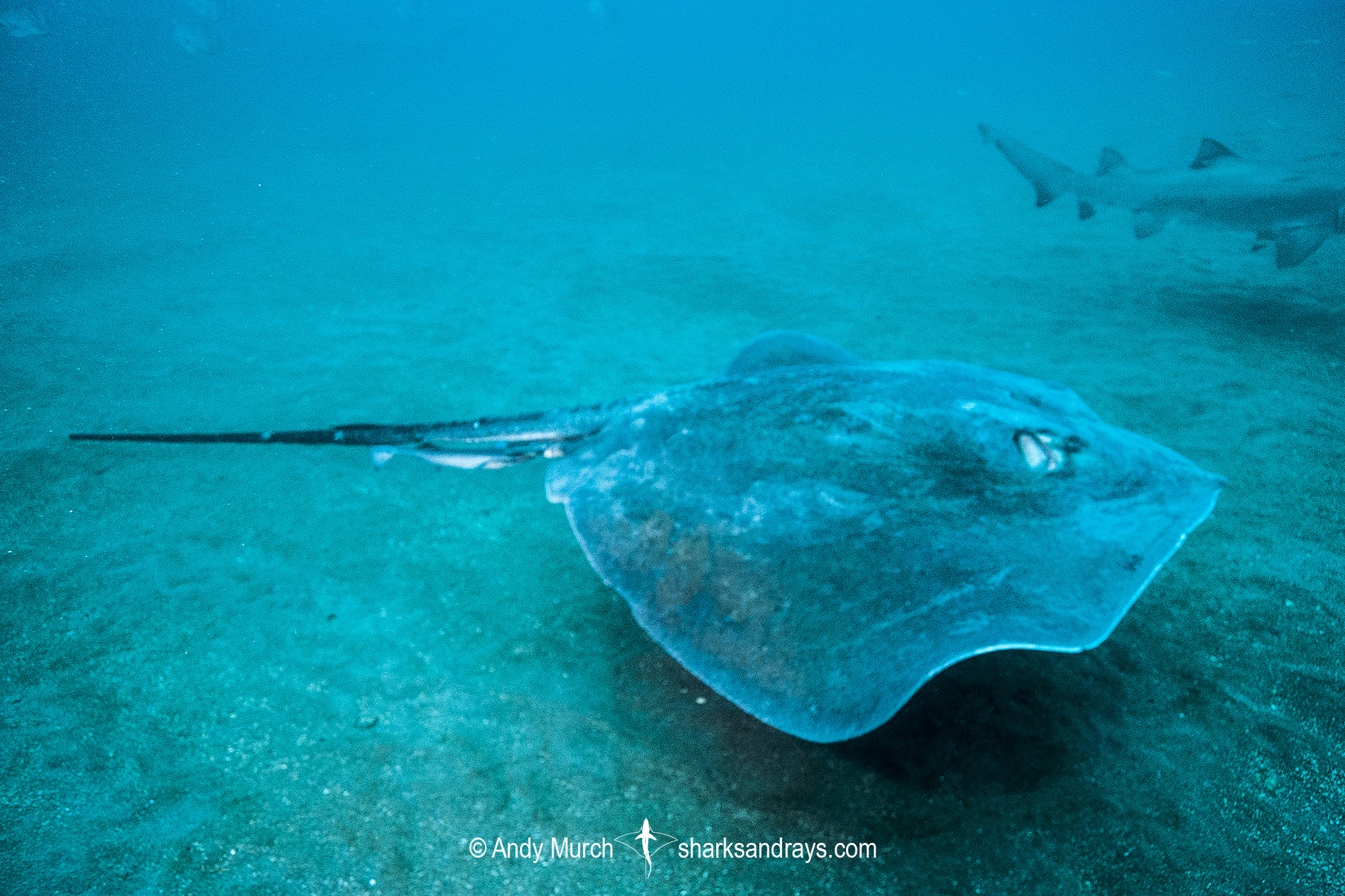Common names
Roughtail Stingray.
Binomial
Bathytoshia centroura.
Synonyms
Dasyatis aspera, Dasyatis centroura, Dasybatus marinus, Pastinaca acanthura, Pastinaca aspera, Raia gesneri, Raja centroura, Trygon aldrovandi, Trygon brucco, Trygon centrura, Trygon spinosissima, Trygon thalassia.
Identification
A very large, thick bodied stingray with a kite-shaped disc that is wider than long; disc width approximately 1.2-1.3 x length. Snout short and obtusely angular with a protruding tip. Anterior margins of disc mildly undulate or slightly convex. Pectoral fin apexes either narrowly rounded or angular. Pelvic fins relatively small with narrowly rounded apexes.
Eyes small. Snout length 1.5-2.5 x combined eye and spiracle length.
Mouth broad, usually containing 6 oral papillae. Weak labial furrows around mouth. Lower jaw weakly convex. Extremely broad, skirt shaped nasal curtain with a weakly fringed margin. Nostrils oval shaped. Juveniles lack dermal thorns but specimens exceeding 50cm DW have a row of stellate thorns and tubercles on midline of back and tail, and smaller thorns on snout and pectoral fins. Tail wide and depressed at base, tapering towards spines and then narrow until tip. 1-3 tail spines present. Tail beyond spines densely covered in thorns. Tail length when intact 1.6-1.8 x disc width. Ventral finfold long and low; base length approximately equal to distance between cloaca and tail spine. Ventral finfold height approximately half tail height.
Colour
Dorsum uniformly olive-brown or grey-brown, with a subtle row of small white pores on each pectoral fin that start close to mid points of the anterior pectoral fin margins, and run diagonally backwards, parallel to the pectoral fin posterior margins. Ventrum white. Ventral finfold usually dark.
Note: in the original description there is no mention of small white pores on pectoral fins but from personal observation, they are clearly present.
Size
Maximum disc width 220cm. Disc width at birth 34-37cm.

Conservation Status
VULNERABLE
The Roughtail Stingray is captured in commercial and artisanal gillnets and trawls, and on recreational hook-and-line fisheries. In the United States, Roughtail Stingray are caught as bycatch by recreational anglers and are often killed. When caught in artisanal shrimp trawl fisheries in southern Mexico roughtail stingrays are generally discarded alive.
In Eastern Brazil, where gillnetting is the predominant artisanal gear, roughtail stingray numbers appear to have decreased in line with other elasmobranchs that are all depleted.
In southern Brazil, all elasmobranch species are either over fished or in a state of collapse.

Habitat
Temperate and tropical seas. On soft substrates, sometimes adjacent to reefs. From shallow bays (including estuaries) to at least 275m. Usually shallower than 100m.
Distribution
Western North and South Atlantic but absent from much of the Caribbean and the northeast coast of South America. The roughtail stingray occurs from Cape Cod and the Georges Bank, southward along the eastern seaboard to the Bahamas and the Gulf of Mexico. Then from Rio Grande do Norte in Brazil to Golfo San Matías in Argentina.
Reproduction
Matrotrophic aplacental viviparity. Litter size 2-6.
Diet
Diet consists mainly of bony fishes, crabs, bivalves, gastropods, and cephalopods.
Behavior
Rests on the substrate for long periods each day. Excavates large depressions in the sand when hunting for benthic invertebrates.
Reaction to divers
Shy but approachable with non-aggressive movements. Generally bolts when approached closely.
Diving logistics
Roughtail stingrays are occasionally seen by divers and beachgoers in the US.
I saw one next to the wreck of the Carib Sea while diving with sandtiger sharks on the Outer Banks of North Carolina.
In the summer months, roughtail stingrays sightings have also been reported from Zach’s Beach in Marthas Vinyard, swimming just off the beach in 2m of water (Tim Costikyan pers. com.).
There are also reports from various locations around Florida although some of these are likely large southern stingrays.
What’s new
View our full list of updates
Similar species
Southern Stingray Distinguished by short rows of thorns on shoulders and a lack of thorns on tail.


